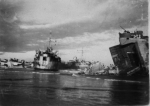 |
76k |
Orange One Beach, Lingayen Gulf, early January, 1945. This photo is from the 40th infantry Division scrapbook and shows the massive
logistics train involved with an amphibious assault. While the landing itself was relatively unopposed, the ships pictured here spent their time under constant attack
from suicided boats and Kamikaze. Early in the morning of January 10th, USS LST-925 (shown parallel to the beach in this picture) was struck by an
explosive charge placed by and enemy small craft. The gunners on USS LST-925 destroyed the boat and crew, but the damage was already done. USS LST-1028
(at a right angle to LST-925) came alongside to render assistance and was also struck by a similar craft before they too
destroyed their attackers. Taking on water and assisted by tugs, both ships elected to beach at the extreme edge of the landing area so as not to interfere with
further landing operations. The ships seen here were at near constant alert throughout their time at Lingayen. Of note, the airfield is clearly visible in the middle
left of the photo and the C-47's and P-51's there indicate a mature beach head when this photo was taken. |
Brian Miller |

